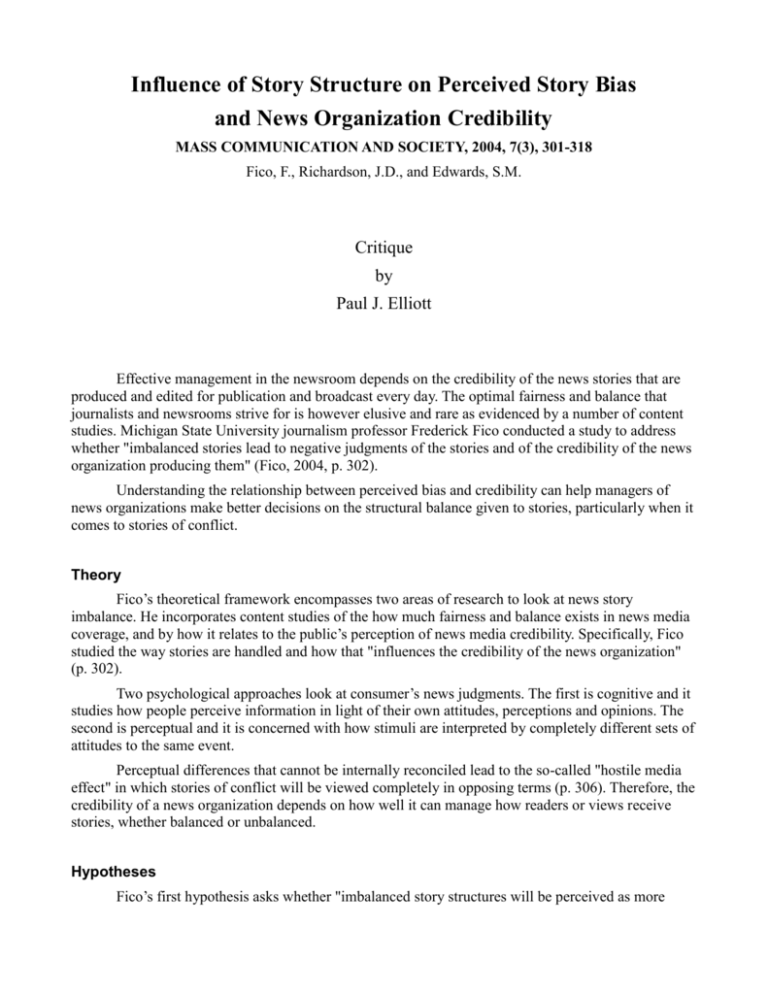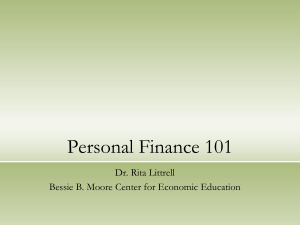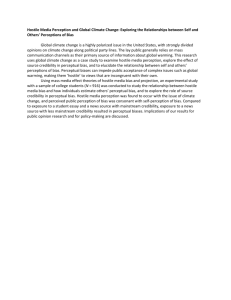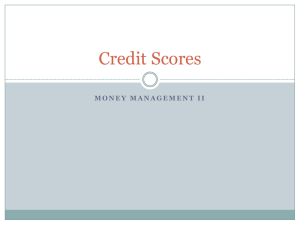DOC - WordPress.com
advertisement

Influence of Story Structure on Perceived Story Bias and News Organization Credibility MASS COMMUNICATION AND SOCIETY, 2004, 7(3), 301-318 Fico, F., Richardson, J.D., and Edwards, S.M. Critique by Paul J. Elliott Effective management in the newsroom depends on the credibility of the news stories that are produced and edited for publication and broadcast every day. The optimal fairness and balance that journalists and newsrooms strive for is however elusive and rare as evidenced by a number of content studies. Michigan State University journalism professor Frederick Fico conducted a study to address whether "imbalanced stories lead to negative judgments of the stories and of the credibility of the news organization producing them" (Fico, 2004, p. 302). Understanding the relationship between perceived bias and credibility can help managers of news organizations make better decisions on the structural balance given to stories, particularly when it comes to stories of conflict. Theory Fico’s theoretical framework encompasses two areas of research to look at news story imbalance. He incorporates content studies of the how much fairness and balance exists in news media coverage, and by how it relates to the public’s perception of news media credibility. Specifically, Fico studied the way stories are handled and how that "influences the credibility of the news organization" (p. 302). Two psychological approaches look at consumer’s news judgments. The first is cognitive and it studies how people perceive information in light of their own attitudes, perceptions and opinions. The second is perceptual and it is concerned with how stimuli are interpreted by completely different sets of attitudes to the same event. Perceptual differences that cannot be internally reconciled lead to the so-called "hostile media effect" in which stories of conflict will be viewed completely in opposing terms (p. 306). Therefore, the credibility of a news organization depends on how well it can manage how readers or views receive stories, whether balanced or unbalanced. Hypotheses Fico’s first hypothesis asks whether "imbalanced story structures will be perceived as more biased than balanced" (p. 309). The second hypothesis tries to determine whether "news organizations publishing structurally imbalanced stories will be perceived as less credible than will news organizations publishing structurally balanced ones" (p. 309). A third hypothesis states that "the more biased the story is perceived to be, the less credible the newspaper publishing the story will be perceived to be" (p. 309). Experiment Fico conducted an experiment on 313 Michigan State University students to measure the effects "the effects of balanced and imbalanced conflict story bias and news organization credibility" (p. 302). The students—all communications majors—were given a questionnaire and asked not to identify themselves. The questionnaires were given out in lecture halls outside of class time. Fico was interested in learning about the students’ opinions on controversial issues and how they were covered. The students were asked questions from fictitious news stories that were presented as actual newspaper clips, and were told after the experiment was concluded that they were fabricated. Three issues looked at were the death penalty, the minimum drinking age and the question of a flat tax. Students were asked to examine the coverage given to one side over the other, the strength of the arguments presented and the quality of the sources. Five elements of credibility were tested: fairness, bias, completeness, accuracy and trustworthiness. All questions were determined to be statistically sound in terms of internal consistency. The stories were pre-tested and broken down to three categories—pro, con and neutral. The stories were roughly the same length and were again pre-tested by faculty members. Independent Variable As the study focuses on the question of balance and bias in stories involving conflict, the independent variable consisted of the balance in terms of space and the prominence given a story. By varying the balance controlled by the study, it should influence readers’ judgments of bias in the story on the level of credibility attributed to the news organization. Imbalance of coverage usually comes from the space and prominence decided on my editors and producers, even after a reporter has filed a story. Since news organizations are expected to fair and balanced in terms of their values, norms, routines and organizational goals, any imbalance is expected to reflect poorly on the journalists and news organization irrespective of the readers’ own biased interpretations. Inherent imbalance of news is comes from reporters being dependent on their sources, how information is selected, quoted and positioned structurally in the news story. Content studies Fico examined the value of content studies of election coverage. A main point that Fico draws from such studies is the amount of credibility that can be lost if the public perceives bias to be present in the news. This is why several studies have already been done to examine bias. Fico does point out that assessing such bias is quite difficult because it depends on subjective analysis, make studies hard to replicate. Fico asks whether constructing more fair and balanced news stories will affect how the public perceived news organization credibility. Findings The study found neutral stories were judged as less biased than the pro and con stories. The one neutral question on the drinking age did show more bias than intended, but that can be attributed to the subjects themselves, rather than the questions. Overall, the data does show that as you manipulate the story balance structurally, you will in turn affect the perception of story bias, in line with the first hypothesis. The data also points out that balanced stories on controversial issues are seen as more credible, supporting the second hypothesis. The more biased stories are perceived to be, the less credible the source. This negative correlation is also shown by the data and supports this final hypothesis. Analysis I find fault with Fico’s choice of issues however. The death penalty is a polarizing question and readers’ views tend to be extreme on this issue, making it difficult to measure degrees of imbalance and bias. The question of a flat tax is a complex economical one not drawn to easy analysis or to strong opinion, especially for college students who are not that away of tax policy. The question on the minimum drinking age can hardly be fairly assessed based on the fact it affects the study participants directly. Therefore, I believe it was not difficult for Fico to come up with data in line with his hypotheses, as they could be expected to be confirmed statistically. Other complex and controversial issues of conflict should also be considered and be subjected to a even higher degree of scrutiny. Additional studies should be done, especially more fine-tuned to measuring imbalance and perceived bias. Further cognitive and perceptual approaches need to be incorporated in testing different audiences that are more diverse than college students all studying different fields of media. In summary, the study and experiment do show a strong correlation between how news stories are structured and how credible they are perceived to be. This is of great worth to newspaper and magazine editors, and television and radio news producers. Being able to structure or re-structure news stories can greatly enhance already diminished news credibility.





